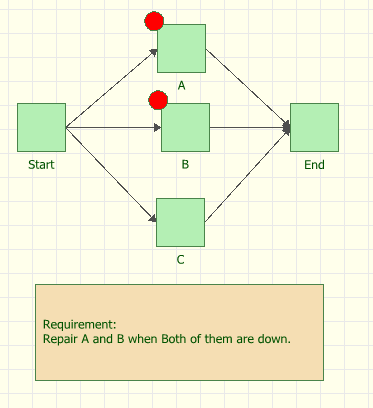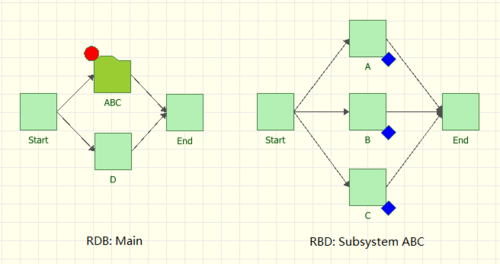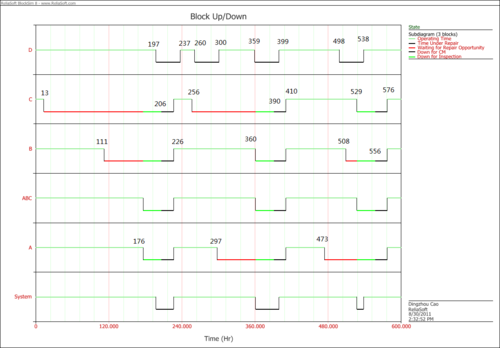BlockSim Example: CM Triggered by Subsystem Down
 |
New format available! This reference is now available in a new format that offers faster page load, improved display for calculations and images and more targeted search.
As of January 2024, this Reliawiki page will not continue to be updated. Please update all links and bookmarks to the latest references at BlockSim examples and BlockSim reference examples.
The purpose of this example is to illustrate how to model the case when CM is triggered by failure of a subsystem. We present two kinds of methods: a method without a subdiagram and a method with a subdiagram. The limitation of the method without a subdiagram is that it cannot model subsystem with more than two devices in parallel or more complex structure. The method with a subdiagram can break this limitation.
Method 1: Without subdiagram
Consider a system with three devices A, B and C are in parallel. A and B form a subsystem, AB. If both A and B fail (i.e., if subsystem AB fails), then start to repair A and B. Device C is in parallel with subsystem AB. The repair of C depends on its failure. When C fails, then start to repair C.
BlockSim Solution
The BlockSim modeling of this system is shown in the figure below.

- The reliability of all blocks follows the Weibull distribution with Beta = 1.5 and Eta = 500 hours.
- Block A and block B belong to maintenance group MG_AB.
- The corrective maintenance of block A and block B are set to "When found failed during an inspection". The CM duration is 120 hours. Upon repair, they are as good as new.
- There is an inspection task for both block A and block B. The inspection is performed based on events in maintenance group MG_AB. If a "Block fails" or a "Start of corrective maintenance" event occurs for any of the blocks in the maintenance group MG_AB, then the inspection is performed. The inspection duration is set to "Immediate Repair" and upon inspection; the device is restored to same as it was when it failed (ie.e, as bad as old).
- The corrective maintenance of Block C is performed upon failure of Block C and the duration is 20 hours. It is as good as new upon repair.
Block Up/Down plot
The system event log is shown in the figure below and is as follows:
- At 271 hours, Block C fails and the repair is finished at 291 hours.
- At 331 hours, Block B fails. Since the subsystem AB is not down (if both A and B fails, then subsystem AB fails), Block B is waiting for repair. (The failure of Block B cannot trigger an inspection of Block B, but this failure would trigger the inspection of Block A. However, Block A has not failed at this time, thus nothing happens).
- At 381 hours, Block A fails and subsystem AB fails. The failure of the subsystem triggers the inspection and then inspection triggers corrective maintenance. (The failure of Block A triggers an inspection on Block B, which is currently failied. Thus corrective maintenance of Block B is performed. Performing corrective maintenance on Block B triggers the inspection of Block A. Since Block A is also currently failed, thus corrective maintenance of Block A is performed too.)
- At 501 hours, both Block A and B are restored.
- At 791 hours, Block B fails and is waiting for repair.
- At 943 hours, Block C fails and get restored at 963 hours.
- At 1358 hours, Block A fails and subsystem AB fails, triggering corrective maintenance for Block A and B.
- At 1478 hours, both Block A and B are restored.
- ...

Method 2: With subdiagram
Let’s a system consists of four devices A, B, C and D. Devices A, B and C are in parallel structure and form a subsystem ABC. Only all A, B and C fail (subsystem ABC fails), then start to repair devices A, B and C. Device D is parallel with subsystem ABC. The repair of D depends on its failure. When D fails, then start to repair D. Method 1 cannot model this system. Here we use subdiagram to model the subsystem.
BlockSim Solution
The BlockSim model of this system is shown in the Figure 5 below. By using subdiagram, we can break the limitation in method 1.
Reliability of all blocks follow Weibull distribution with Beta = 1.5 and Eta = 100 hours. Subdiagram block ABC belongs to maintenance group MG_ABC. CM of Block A, B and C are set to "When found failed during an inspection". The CM duration is 20 hour. Upon repair, they are as good as new. There is an inspection for Block A, B and C. The inspection is performed based on events in maintenance group MG_ABC. If "Block fails" event occurs for any of the blocks in the maintenance group MG_ABC, then the inspection is performed. The inspection duration is 30 hours. Upon inspection, the device is restored to as bad as old. CM of Block D is performed upon failure of Block C and the duration is 40 hours. It is as good as new upon repair.

Block Up/Down plot
The system event log is shown in Figure belwo and is as follows:
- At 13, Block C fails. Since subsystem ABC doesn't fail, Block C waits for repair opportunity.
- At 111, Block B fails. Since subsystem ABC doesn't fail, Block B waits for repair opportunity.
- At 176, Block A fails and brings down the subsystem ABC. Failure of subsystem ABC triggers the inspection of Block A, B and C.
- At 197, Block D fails and get repair at 237.
- At 206, Block A, B and C finish inspection and trigger CMs. CM is performed on Block A, B and C.
- At 226, Block A, B and C are restored.
- ...
